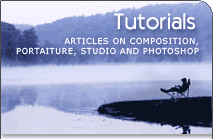Wide Angle Lens
Here comes the time when I am going to talk about wide-angle lens. This lens is my favorite. I cannot say exactly why, but I can give you a few points that I like most in the lens. And those points are: stretching the perspective, making the object that closer to the lens look much bigger (in relation to all other objects), the lens allow you to fit a lot of things into the image and there is certain dynamics added by the lens to the image (it could be because of the distortions, which such lens inevitably bring to the photograph). There is one more thing, when you photograph a certain subject, the lens require to get close, real close, to the subject and it makes the subject kind of very personal for you, you feel it better, if you see what I mean. Well, better we start talking about all those things in details:
Perspective
One of the most interesting features of wide-angle lens is "the capability to stretch perspective". What do I mean by that? I mean that when you look through a wide-angle lens, it seems that the distance between objects has extended. The objects that were not so distant could appear too far away. And the proportion of objects dramatically increases, so the one that close to the camera look enormous, but those, which are father away almost disappear in the distance.
But there is a quirk - it's not a physical thing, but an impression we get. As one of the readers (signed as FL) has noted (and thanks for that):
The connection between focal length and perspective in your explanation is false. The only thing you have done is choosing an arbitrary position in space that the three lines are to intercept at. If this position is not the same position as the camera, it only shows that you have moved. And that is exactly what has changed the perspective, you moving, not the change in focal length. Change in focal length without moving does nothing to the perspective. Moving does a lot to the perspective, also when keeping the same focal length. Perspective and moving is strongly related. Perspective and focal length is not related in any way (other than you might have to move in order to get your arbitrary position inside the frame, which in turn will change perspective).
Viewing angle on the other hand, is related to focal length, but a larger/smaller viewing angle will not change the perspective, not even a bit. Try drawing all three lines from the same point on the base line (where the camera sits) and see for yourself that the perspective does not change, only the viewing angle. Or even better, do this test: Take two pictures, from the same position without moving, one with say 28 mm focal lebngth, the other one with for example 100 mm. Crop the 28 mm image and resize it, so it has the same scale as the 100 mm. Lay them ontop eachother, and voila: The perspective is the same, despite the different focal lengts. You can also google for "focal length perspective myth" and see some examples (for example this one ) without making your own experiment (but experimenting is much more fun). You will also discover, if you examine the pages returned by google, that the exact same thing goes for focal length and DOF (depth of field).
And I have to agree with this comment. In order for the object to fit entirely into the frame - we move and as such change the perspective. So the primary driver of the change is the viewing angle and the fact that we step back or forward to adjust what gets into the frame. Though the final effect and impression is still of the "stretching perspective", which is just an impression. So, when you read my words about "stretching perspective", keep in mind that this applies only to our impression (since we have moved to achieve the desired result).
The effect caused by various focal lengths on the perspective I described in one of the previous articles. But I will try to dive deeper and describe in more details here.
Here is the basic comparison of impression between different types of lenses:
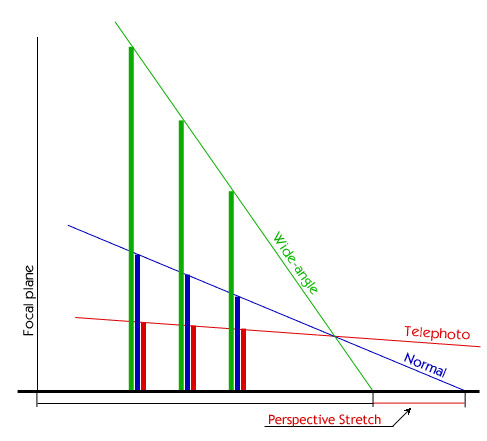
The image shows how different lenses affect the perspective. The wider the angle the shorter the stronger the difference in the sizes of the elements in the photograph. If you look at the point where the green line with the label "wide angle" intersects with the axis, this is a point, which I would call perceptive vanish point for wide angle lens. What do I mean by that? Well, theoretically at this point and beyond (at this distance from the focal plabe) all elements would be represented as a dot or not visible at all. For normal lens (of in reallity) this vanishing point is somewhat farter from the focal plane than for the wide-angle lens — the intersection of the blue line and the axis.
What do those two points mean? They mean that the wide angle lens reduce the actual distance to the vanishing point. Which results that our brain, when judging the distance and sizes of the objects in the photograph, assumes that the distance to the vanishing point is the same as with normal lens (i.e. reality). But this assumption makes it to stretch the perspective recorded in the image to the normal one. This stretch is indicated at the right bottom corner of the picture above with the red ink.
~ Top ~Making it big
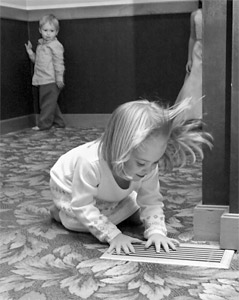 Let's
take for example a simple situation (the image to the right), where we have
two kids, which should be of similar size. The girl is playing with the A/C
vent while the boy is watching. This shot was made with a wide angle lens.
What effect the lens brought here? First of all compare the size of the girl
and the boy. The boy probably is from two to three times smaller than the girl, while
in reality their somewhat of the same height. OK, the perspective added its
effect and make the boy seem smaller. But in the reality the boy is not that
far away. On the photograph I would guess there is 15-20 feet (5-7 meters)
between the boy and the girl, actually only 10-12 feet separated them at
that moment. So here you see the first effect of the wide angle lens — stretching
perspective. And I should say that there is additional benefit for a photographer
in this. Because the girl appear to be bigger than the boy she becomes the
main subject without any doubts or additional thinking, we just assume it
by judging the relative sizes of subjects/objects in the frame. It means
that with wide angle lens its much easier to focus viewer's attention on
the primary subject — the size matters. If we consider the relative sizes
and how it reduces the significance of the objects/subjects that farther
away from the camera, we can say that the other elements of the photograph
(not the primary one) easily become the background for our primary subject.
And this trail of thought leads me to a conclusion that by using wide angle
lens we can separate the subject from the rest of stuff in the image by making
all other elements to become the background. It looks like we push all other
elements farther away from the camera and pull the subject much closer to
the camera.
Let's
take for example a simple situation (the image to the right), where we have
two kids, which should be of similar size. The girl is playing with the A/C
vent while the boy is watching. This shot was made with a wide angle lens.
What effect the lens brought here? First of all compare the size of the girl
and the boy. The boy probably is from two to three times smaller than the girl, while
in reality their somewhat of the same height. OK, the perspective added its
effect and make the boy seem smaller. But in the reality the boy is not that
far away. On the photograph I would guess there is 15-20 feet (5-7 meters)
between the boy and the girl, actually only 10-12 feet separated them at
that moment. So here you see the first effect of the wide angle lens — stretching
perspective. And I should say that there is additional benefit for a photographer
in this. Because the girl appear to be bigger than the boy she becomes the
main subject without any doubts or additional thinking, we just assume it
by judging the relative sizes of subjects/objects in the frame. It means
that with wide angle lens its much easier to focus viewer's attention on
the primary subject — the size matters. If we consider the relative sizes
and how it reduces the significance of the objects/subjects that farther
away from the camera, we can say that the other elements of the photograph
(not the primary one) easily become the background for our primary subject.
And this trail of thought leads me to a conclusion that by using wide angle
lens we can separate the subject from the rest of stuff in the image by making
all other elements to become the background. It looks like we push all other
elements farther away from the camera and pull the subject much closer to
the camera.
Though there is one side thought, it may not always be possible to get close
to the subject and enforce that distance between elements in the photograph.
It only works when you are very close to the subject, otherwise the use of wide
angle lens will have the opposite effect — it will blend your subject
with the rest of the elements in the photograph. And sometimes it may even
worsen things, such that some insignificant object on front plane becomes
almost huge and draws a lot of unwanted attention. That's why there are limits
to this techniqe, as always  .
.
Seeing a lot
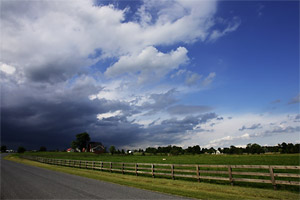 So,
by pushing the subject farther from the camera we blend it with background.
But what if we need to include a lot of the scene? What if there is no single
subject? Let's say there is a vista or a big room full of people (some kind
of event) and we want to get everything into the frame. Well, again the wide
angle lens could be your choice, because the name of that range says it's
all. Wide angle means that you can fit a lot of stuff into the image, like
on the image to the left.
So,
by pushing the subject farther from the camera we blend it with background.
But what if we need to include a lot of the scene? What if there is no single
subject? Let's say there is a vista or a big room full of people (some kind
of event) and we want to get everything into the frame. Well, again the wide
angle lens could be your choice, because the name of that range says it's
all. Wide angle means that you can fit a lot of stuff into the image, like
on the image to the left.
Though when you put a lot of stuff into the image everything becomes small and less significant. And then the emphasis shifts to the overall "wow" effect. When the quantity of elements and their relation to each other play more importance over the qualities of a single element, the expanded view becomes the primary subject.
Wide angle lens help when there is a limited space and you need to jam a big subject into the picture. One of the examples is the interior design photography. Let's say we have an assignment to take photographs of a kitchen, which I had some time ago. In my case I had plenty of room to move around, the kitchen was for show, not for real purposes. But there are times when you the space is a great issue, then the only choice is to use a wide angle lens, if you are not focusing on the details and need the overall view of the room.
~ Top ~Dynamics and distortion
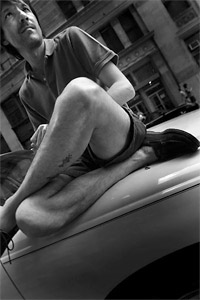 If you look at this street portrait, which I've taken with "a hidden
camera" (I just pointed the camera without looking through the lens at the man from the waist level at
pressed the shutter). The lens, of course, was the wide angle one — at its
widest angle. What does the picture show us in regards of the graphics? My
first answer would be the disproportion of the man's limbs, his legs seem much bigger
in relation to his whole body than a person usually would have. That is one
of the the distortion effects which I wanted to point out. It relates to
the "Making it big" issue covered earlier in this article. The
body parts of the man, which are closer to the camera (in our case those
are the legs) appear to be bigger than his other limbs, which are farther
away. Such a distortion sometime may add a funny look to a portrait or highlight
specific features of the subject. You probably have seen many images taken
with a fish eye lens — the lens that cover 180 degrees and with most distortions.
The first example that comes to my mind is a picture of a dog, which is sniffing
the camera. The nose of the dog has the size of the dog's head, which makes
it so funny.
If you look at this street portrait, which I've taken with "a hidden
camera" (I just pointed the camera without looking through the lens at the man from the waist level at
pressed the shutter). The lens, of course, was the wide angle one — at its
widest angle. What does the picture show us in regards of the graphics? My
first answer would be the disproportion of the man's limbs, his legs seem much bigger
in relation to his whole body than a person usually would have. That is one
of the the distortion effects which I wanted to point out. It relates to
the "Making it big" issue covered earlier in this article. The
body parts of the man, which are closer to the camera (in our case those
are the legs) appear to be bigger than his other limbs, which are farther
away. Such a distortion sometime may add a funny look to a portrait or highlight
specific features of the subject. You probably have seen many images taken
with a fish eye lens — the lens that cover 180 degrees and with most distortions.
The first example that comes to my mind is a picture of a dog, which is sniffing
the camera. The nose of the dog has the size of the dog's head, which makes
it so funny.
The other effect of distortion is that the straight lines that cross the frame may appear not that straight. The farther from the image center the line crosses the frame the more it will be bent by the optics. Sometimes with fish eye lens it seems like a couple of lines create a circle around the lens. That's how strongly a distortion can affect the scene in the photograph.
But we have not talked about the dynamics. Where are the dynamics in the photograph created with a wide angle lens? In my mind the dynamics in all aspects described above: the stretch of perspective, the differences of the subjects, which are on different distances from the camera, the unreal proportions of known shapes and forms and the distortion of the straight lines (or any other usual and known graphic elements).
~ Top ~Getting personal
Among those technical aspects of the wide angle lens, there is one, which add its own appeal to me. Considering that you are using the wide angle lens to take photographs of a person, you are bound to come closer to the subject. Coming closer, huh? It means that most probably the person would notice you and your camera, which will almost touch him or her. And if your are noticed by the subject, then the attention will be turned at you and all the activities or interested that kept that person busy and made him/her interesting for you will be forgotten for a little while. And the scene, which you were hunting for, is gone. It seems like you are loosing the advantage of candid shot and are left with a posed one.
Not at all, if you stick just for a few more minutes and spend some time around the subject, the person will be bored with you and will shift his attention to some other, more interesting activities or objects. That's the moment we have been waiting for — we are close and unnoticed. And the time, which we spent waiting for that we made an invisible connection with the subject. We learned about some personal side and probably made some impressions and conclusions. All those small things count, they will appear in the photograph, it will create that personal touch and add the mood to the photograph, which is based on the photographer's understanding and impression of the subject. I consider this side-effect of the wide angle lens one of the important aspects. And even if the subject is a simple rock laying in the grass, we will have to pay more attention to the rock and by doing so we cannot escape a deeper impression. This personal connection makes as think more about what subject we select to include into the frame and what we know about it, what we want to express, which is the core of photography.
~ Top ~Technical stuff
There are a few technical things that you may need to know when using the wide-angle lens. Here is the short description of those (I am not that much into technicalities):
- Lens Hood and Flare — because the lens covers a very wide area there is a great chance that the sun could mess with your image. To overcome this small problem most of the lens are suipplied with a lens hood. The hood creates a protection from the sun, but there are two things that collide: the lens is created to allow view as much as possible and the hood tries to provide a protection from the sun. These two concept are somewhat contradictory, so one of them should give in, and that's why the hood for wide angle lens is not such a good protection after all. So, it's your job to watch for the flare and it may be useful to use some other objects (such as a sheet of black card) to protect the lens from the sun rays.
- Polarizer — with polarizer you have two concerns. One of them is that the simple thickness of the metallic rim around the glass may cause vignetting. The other one is the unevenness of the effect, which is partially depends on the all those various reflection angles that these lens will let through. If we take for example the sky, the best effect will be when the sun and the camera are at 90 degrees to each other. Though the lens cover a lot more of other angles, where the angles will vary from 45 to 135 degrees. As well I noticed that even without the polarizer the lens saturates the sky more than any other types of lens.
- Depth of Field — the design of the wide angle lens and its optical constraints make the DOF bigger than with any other types of lens. It's very hard (almost impossible) to have a shallow DOF with such lens, so look for other ways to simplify background (such as framing).
- Sharpness — if you have a wide angle zoom lens than you may notice slighter less sharpness at the very wide angle, especially with the widest aperture. That's another design constraint, which very hard to avoid as I understand (almost any wide angle zoom lens has this drawback, even the best lens).
- Vignetting — some lens (especially of cheaper price range) may have dimness in corners at the widest angles and apertures. You may want to check this issue before buying the lens.
- What else? — Well there is a good article Learn
to use wide angle lenses effectively by Nelson Tan, which covers
other technical things about this type of lens. I recommend to check
it out.
![End of the article [end of the text]](http://www.romanzolin.com/img/misc/text_end.png)
